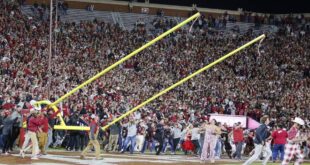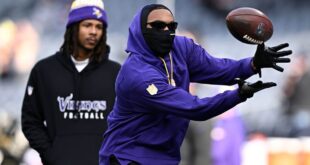Is NHL officiating bad? Trick question, I know. Because viscerally, most people who follow the NHL as a supporter of a single team would almost universally answer, yes, it is.
When people are asked to consider officiating in the abstract, they usually begin by saying they just want it to be consistent. They want a penalty in the first minute to be a penalty in the last minute. And when it comes to the most controversial moments, which nowadays usually involve what is or isn’t goalie interference, they wonder: How come no one ever knows what the final decision is going to be?
And the easy answer is, goaltender inference — like so much of what is involved in NHL refereeing — requires a judgment call. Every play is different which means there’ll never be a one-size-fits-all answer to satisfy everyone.
Incidentally, all of this ruminating about the state of officiating is because recently, while pawing through an old copy of the NHL’s Official Guide and Record Book, I came across a page outlining the most significant rule changes in league history. I realized we are at a significant anniversary — and no one is talking about it.
That anniversary: the 25th year since the adoption of the two-referee system. And even that requires a caveat. Because the NHL’s decision to go from one referee to two was actually phased in over a three-year period, between 1998 and 2000.
Prior to that, NHL games were officiated by a single referee and two linesmen. The decision to adopt the new protocols over a 36-month span was made primarily to train enough new staff, given that the league was effectively doubling its refereeing workforce.
In the first season of the new system, 1998-99, each team played only 20 games with two referees. The remaining 62 were played, as in the past, with just a single referee. The major shift came the next season when each team played 50 games with two referees, 25 at home and 25 on the road. By 2000-01, the system was fully integrated — and its implementation created a seismic shift in how the game was played.
“Going to two referees was one of the biggest innovations of all time in hockey,” said David McNab, a longtime NHL executive. Former NHL coach Dave King called the shift to two referees “the most significant on-ice change of the Gary Bettman era.”
Former NHL defenseman Cory Sarich, now an analyst on the Calgary Flames’ television broadcasts, says the way a player approached the game had to change once a second referee appeared on the scene — primarily because now there was a second set of eyes trained on players, which forced them to be more watchful about exchanges that happened behind the play.
“There was no more getting away with the chippy little plays when you were exiting your own end,” explained Sarich. “That was the time when you could get in a cheap shot on somebody, or a little bit of retribution — when the refs’ eyes weren’t around. You could just delay a little bit and as soon as the referee turned his head, you could chop the guy in the back of the legs, or jab him, or pop him in the lips with your glove or give him a big face wash — things like that.
“All the little crap that went on when the referee had his back turned, that’s probably the biggest thing that went away. I’m sure the linesmen saw a lot of what was happening, but they didn’t have the power to call that. It all fell on one referee.”
According to King, switching to a two-referee system eliminated a lot of the holding, hooking and interference that went on behind the play, which in turn helped the league get most of the obstruction out of the game.
“It had gotten to the point where the skill players couldn’t show what they could do,” said King. “It became clear to the people in New York that they couldn’t take fighting out of the game, so they said, ‘We’ve got to take this other baloney away.’
“Back in 2007, I made a presentation at a coaching clinic in Sweden where I took old video of the NHL, before the two-referee system. I had gotten together all kinds of clips of plays that weren’t called, things you could not believe players were getting away with. It was about four minutes long — and the audience’s response to seeing this video was to laugh.
“And I thought, that’s the best reaction I could have gotten. Some of these were young coaches, who couldn’t believe what they were seeing. Guys were literally getting tackled. They may as well have gotten out a rope and tied them up, like in the rodeo. But that was the thinking back then: if they weren’t going to call it, you kept doing it.”
King, who coached the Calgary Flames and the Columbus Blue Jackets in the 1990s, noted that in the first year of the two-referee system, his pre-game messaging to players would shift.
“That first year of the two-referee system, we got just 20 games with the two referees,” said King, “so if it was a game with two referees, you’d remind your guys, ‘tonight, we’ve got two officials so this is what we can and can’t do.’ And not every player could make the adjustment. Some weren’t great skaters and had to rely on their sticks to hold people up. They knew this might be the beginning of the end for their careers.”
Technology and officiating
Technology has changed how different sports make calls. Wimbledon this year is going to electronic line calls. Baseball is trending toward using the available technology to call balls and strikes. Every scoring play in the NFL is automatically reviewed. Ultimately, hockey may be able to determine whether a puck fully crosses the goal line via a microchip in the puck. Offside challenges are simply a fact of NHL life today.
The NHL was at the forefront of video innovation when it introduced the situation room in Toronto, which — on a nightly basis — has a staff in place, to review calls and otherwise assist referees when there are coaching challenges or questions relating to whether a puck has definitively crossed the goal line for a good goal.
But the vexing problem — of getting everybody to agree on the correct outcome, if it’s a maybe-yes, maybe-no grey area — remains, according to McNab.
“NHL hockey is probably closest to NFL football because there are so many judgment calls,” said McNab. “That’s where it’s impossible to make everybody happy — and why it’s impossible to go strictly to computers or cameras to make the calls. That would be hit-and-miss as well.”
The million-dollar question
Circling back to our original question, is NHL refereeing any good?
“That’s a tough question to answer because as coaches, we’re never really satisfied with the refereeing, but yes, I think it is,” answered King. “Back before, when we had one official, I always thought there were lots of calls, blatant calls that were missed. Now I think it’s almost reversed. They probably call too much. Things that are pretty subtle and don’t make any difference in the game are called and you think, why? It has no impact on the game.
“Whenever you go to a coaching conference now, or do a podcast, everybody talks about playing fast. The one thing that’s overlooked is, the two-referee system is really the reason you are allowed to play fast. A speedster can use his speed. Whereas in the old days I used to have guys that could really fly, but they had the stick on them all the time, going through the middle zone. At one time, I thought our game looked too much like wrestling.
“There are nights now when the game looks over-refereed, but in the grand scheme of things, it’s a major improvement. It’s been good for the game.”
Sarich agrees that while referees may have good nights and bad nights, the same way players do, the overall standard is pretty good.
“I think it is,” said Sarich. “I always say, there are two jobs I’d never want — being a ref or being a head coach, because someone always hates you. When everything goes smoothly, and both sides are happy, and there are no blown calls, no one ever says, ‘That was an amazing job by the refs.’ There’s no credit for those guys. It’s a thankless job.”
Sarich began his NHL career in 1998-99, the first year the league started the transition to the two-referee system. But he played his entire junior career with a single referee and was there, at the start, to see how the NHL integrated the new system. And while he thinks it is impossible to go back, Sarich does think something was lost when the league switched away from a single referee calling penalties.
“Back then, because there were less of them, and you saw them more often, in some instances, you could form a relationship with the referees and linesmen,” said Sarich. “Sometimes, that could be advantageous. Sometimes, not.
“I remember, with (former referee) Kerry Fraser, I got on his bad side, right to begin with, and I paid the price almost every time I played a game that he called. I almost had myself chalked up for a trip to the box every time I saw him — because I probably insulted him, or did something early. It was a more personal time. Now, you have way more refs and because of the rotation, you don’t see the same guys as often. So a little bit of that has been taken out of the game. It used to play to some guys’ advantages — and sometimes, to a disadvantage. If a ref got a sour taste about you, and you saw them all the time, it didn’t help.”
King believes it was easier for a single referee to manage the game compared to today, when the two referees have to read off each other and might not always agree on what they see.
Back when it was just one referee, he alone could dictate how to call a game. Some might call it tight. But frequently, others would just let them play.
“I remember once, a referee came over after a close playoff game that we lost and apologized; and explained, ‘I didn’t want to be a factor.’ We were playing against a team that we outshot something like 63 to 21 — and we lost.
“And my answer to him was, ‘Yes, you did affect the outcome. Because you didn’t call a lot of penalties, they were able to tackle our players in the corner.’ I said, ‘You can’t escape the game. You either call it or you don’t — but either way, you have an impact on the outcome.’”
No matter how officiating evolves in the future, McNab can’t imagine the league ever going back to having just a single referee on the ice, even if he gets extra technological help from the press box or the situation room in Toronto.
“Can you imagine having a triple-overtime playoff game with just a single referee, and having him try to keep up with the play, skating back and forth and not missing things that would have an impact on the outcome of the game? He’d be exhausted,” said McNab.
“The two-referee system has made refereeing — not easy, because refereeing is not easy — but easier because the guy behind the play only has to cover half the ice and has a view of everything that’s going on in front of him. Trying to call a game now with one ref? With the speed of today’s game? It’d be impossible.”
The Oil watch
The Edmonton Oilers will receive the first major test of the Kris Knoblauch era now that center Connor McDavid has been officially ruled out for two-to-three weeks with an ankle injury suffered in last Monday’s loss to the Columbus Blue Jackets. That timeline constitutes good news, given that the Oilers don’t have an especially difficult schedule between now and the middle of November which, if the prognosis is accurate, suggests McDavid could be back by mid-month. That would coincide with the start of a three-game eastern Canada road swing on Nov. 16 in Toronto. And if McDavid is back then, it’ll mean just a seven-game absence. The Oilers played their first game without their captain Thursday vs. Nashville and went into the game with a mediocre 4-5-1 record.
Still, that was better than this time last year, when they limped out to a 3-9-1 start, prompting the Oilers to fire Jay Woodcroft and replace him with Knoblauch. The turnaround was almost instantaneous. People may forget: McDavid was in the midst of an eight-game goal-scoring drought during last year’s slow start but scored in Knoblauch’s first game. The Oilers won their first two with Knoblauch behind the bench, then lost three, won eight, lost three more and then won 16 in a row between Dec. 21 and Jan. 27. In fact, the winning streak ended in the first game out of the All-Star break, against Vegas in early February, but by then, they’d recovered to a 29-15-1 record and eventually made it all the way to seventh game of the Stanley Cup Final.
All of which is to say that based on recent history, the Oilers with a healthy McDavid are capable of turning it around after a slow start. In some ways, while the Oilers muddle along without him, they may be able to test some new line combinations and see if newcomers such as Viktor Arvidsson and Jeff Skinner can assert themselves more with enhanced roles.
Speaking of bad injury luck …
Ross Colton had been thriving as a member of the Colorado Avalanche’s top line, making the most of a chance to play with Nathan MacKinnon by scoring a team-leading eight goals in the team’s first 10 games. Colton broke his foot this past Monday stopping a shot in a game against the Chicago Blackhawks; he’ll be out six to eight weeks. So a mid-December return at the earliest, and in the meantime, the Avalanche’s depth at forward — already tested by the absences of Jonathan Drouin, Artturi Lehkonen, Valeri Nichushkin and Gabriel Landeskog — is put under even more pressure.
In the short term, it meant that Wednesday, in a loss to Tampa Bay, Joel Kiviranta was promoted to the top line alongside MacKinnon and Ivan Ivan replaced Colton on the first power-play unit (and promptly responded with a goal). Defenseman Oliver Kylington, who was signed as a free agent this summer from Calgary, played sparingly at forward and T.J. Tynan, a star at the minor-league level, also drew into the lineup and got 8:36 of playing time. Tynan will be interesting to watch, because he’s always scored at a lower level, mostly in the L.A. Kings’ organization, but has never really gotten an NHL chance. Is this the opportunity he’s been waiting for? Desperate times, as coaches keep reminding us, do create unexpected opportunities.
(Top photo of NHL referees Kyle Flemington and Dan O’Rourke: Dilip Vishwanat / Getty Images)
Source link
 meganwoolsey Home
meganwoolsey Home




